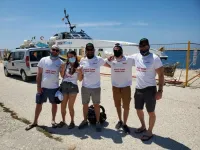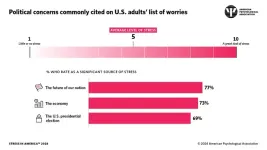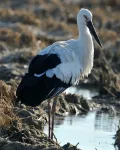(Press-News.org) The Mediterranean Sea is a paradise.
Pristine waters and an incredible coastline spanning multiple continents that are renowned the world over.
Below those picturesque, and sometimes crowded, waters swim a legendary creature facing a treacherous and uncertain future: the white shark.
Francesco Ferretti, an assistant professor in the College of Natural Resources and Environment, is working to save one of the most endangered white shark populations on the planet. The research team located signs of the remaining white sharks in the Sicilian Channel.
“We decided to take on the challenge of locating the last remaining white sharks in the Mediterranean and saving them,” Ferretti said. “One of the most critical steps was tagging individuals so we could learn more about their abundance and distribution. This led to the ‘White Shark Chase,’ an initiative where we began identifying areas in the Mediterranean where these animals might be found. It was not easy as these sharks are rare.”
Incredibly rare, in fact.
Unlike places like California, where the sharks gather near seal colonies, they have no known aggregation areas in the Mediterranean. Finding them felt like searching for a needle in a haystack, or, more aptly, a grain of sand in the sea.
Taylor Chapple, an assistant professor at Oregon State University at the Coastal Oregon Marine Experiment Station and white shark technical expert on the project, was a postdoc with Ferretti at Stanford and they have continued to work together ever since.
“These animals likely have a very different ecology than the white sharks from other global populations,” Chapple said. “These seem to be more likely based on tunas and smaller fish. It almost flips our understanding of white sharks on its head. It allows these animals that are a couple of tons – bigger than any land perdators – to exist on a resource that is very surprising. Seals are very fatty, and these sharks are feeding on tuna and still getting this large.”
This research is the first step in establishing a monitoring program for the sharks in the region in the ongoing efforts to help prevent the animal’s extinction in the area.
The research was published in Frontiers of Marine Science on Oct. 22, 2024, and was done in collaboration with Jeremy Jenrette and Brendan Shea of the Department of Fish and Wildlife; Shea and Austin Gallagher with Beneath the Waves; Chiara Gambardella with the Polytechnic University of Marche; Gambardella and Stefano Moro with Stazione Zoologica Anton Dohrn; Khaled Echwikhi with University of Gabes and High Institute of Applied Biology of Medenine; Robert Schallert and Barbara Block with Stanford University; Schallert with Tag-a-Giant; and Chapple with Oregon State University’s Coastal Oregon Marine Experiment Station.
Funding was provided by The Explorers Club, Discovery Channel, Sharkproject, the Bertarelli Foundation, the Augmentum platform, and individual donors.
Ferretti organized three pilot expeditions in 2021, 2022, and 2023, focusing on what we believed to be hotspots for the species – the Sicilian Channel. These expeditions used improved methods and technologies compared to previous efforts, such as environmental DNA (eDNA) sampling, which detects traces of animal DNA in water, like using a dog to sniff out an animal’s presence. The researchers also used surface and deepwater cameras with bait to attract the sharks, and chumming to try and lure them closer.
During the expeditions, they detected the presence of white sharks on five occasions at the four sites. The team was correct in their choice of location and timing of May through June, but did not interact directly with the sharks.
“They are extremely sparse, and we realized that even with our efforts, we weren't working on a large enough scale,” Ferretti said. “We need to recalibrate our approach and develop new strategies. Despite these challenges, we were able to identify a stronghold of this population, particularly in the southern Sicilian Channel off northern Africa. This area is highly impacted by fishing, and it is where we are focusing our efforts now. The pilot expeditions allowed us to recalibrate for a larger program and provided valuable insight into where to focus future efforts.”
Stormy seas
The research team, which included graduate students from Virginia Tech, used leisure boats, which, while suitable, were far from ideal as they were not dedicated research vessels. They lacked space, speed, and the necessary equipment to properly store chum material—primarily bluefin tuna, which is highly regulated in the Mediterranean and difficult to source continuously.
“We were able to carry out our research, gathering vital data that will guide future expeditions,” Ferretti said. “It was a demanding but crucial part of our ongoing efforts to protect this endangered population.”
The journeys took the team from Marsala, on the northwest tip of Sicily, to various islands like Lampedusa and Pantelleria, as well as Tunisia and Malta, deploying long-line cameras and collecting eDNA samples along the way. However, the intense commercial boat and fishing traffic in the Sicilian Channel made things challenging, and the researchers had to monitor their equipment closely to avoid collisions with ships.
In 2023, the team utilized a large 87-foot sailing yacht to conduct open water research and had a film crew document the mission.
While they did not directly see any white sharks, they successfully tagged a Mako shark for the first time in the region as part of another research project.
And, Ferretti said, the path for future research missions has been set.
The next horizon
Now, the research team is planning and fundraising for multiple future expeditions in the Sicilian Channel and beyond.
“We know that one hot spot is there, but there may also be other important areas in the eastern Mediterranean Sea hosting critical habitat such as a nursery,” Ferretti said.
The researchers are implementing a series of approaches, including monitoring ports in North Africa to track interactions between fishers and sharks and collect biological material. This allows them to gather genetic and isotopic samples for analysis. Through isotopic analysis, they can learn more about the population’s structure, diet, and changes in habitat as the sharks grow.
“We don’t do research in a vacuum,” Chapple said. “The research we do now is so multi-disciplinary and the questions that we can ask now are not achievable as a single entity. This white shark chase – there is so much knowledge held in local communities and stakeholders, that as a scientist we cannot step in there and say this is what we should do. These multi-institutional collaborations are critical for understanding the animals, the systems, and the culture that happens around the research.”
These collaborations across not only universities, but also regions, add additional tools to the researchers’ toolbox to improve effectiveness.
“We are expanding our network of local and international collaborators to maximize the value of the data we collect and establish a proper monitoring program for the Mediterranean,” Ferretti said. “Currently, there is no formal monitoring or conservation program in place for this population. We want now to keep monitoring this population because we do not want to lose it.”
Contact:
Max Esterhuizen
540-231-6157
END
Virginia Tech researcher works to preserve the white shark in the Mediterranean Sea
The research team went on a ‘White Shark Chase’ in the Sicilian Channel and located evidence of white sharks at four sites.
2024-10-22
ELSE PRESS RELEASES FROM THIS DATE:
How the coronavirus defeats the innate immune response
2024-10-22
The novel coronavirus SARS-CoV-2 has an enzyme that can counteract a cell’s innate defense mechanism against viruses, explaining why it is more infectious than the previous SARS and MERS-causing viruses. The Kobe University discovery may point the way to the development of more effective drugs against this and possibly similar, future diseases.
When a virus attacks, the body’s immune response has two basic layers of defense: the innate and the adaptive immune systems. While the adaptive immune system grows stronger against a specific pathogen as the body ...
APA Poll: Future of nation, economy and presidential election top U.S. stressors
2024-10-22
WASHINGTON — More than 7 in 10 adults said the future of the nation (77%) is a significant source of stress in their lives, with the economy (73%) and the 2024 U.S. presidential election (69%) following closely behind, according to the latest Stress in America™ survey released today by the American Psychological Association.
At the same time, the poll found many common stressors among people with different political party affiliations. The survey was conducted by The Harris Poll on behalf of APA among more ...
Towards better solar cells: Exploring an anomalous phenomenon of electricity generation
2024-10-22
The bulk photovoltaic (BPV) effect is an uncommon phenomenon that may enable certain materials to outperform the conventional p–n junctions used in solar cells. In a recent study, researchers from Japan have experimentally demonstrated the BPV effect in alpha-phase indium selenide (α-In2Se3) for the first time along the out-of-plane direction, validating previous theoretical predictions. The remarkable conversion efficiency recorded in their α-In2Se3 device signals a promising advancement for future solar cell technologies and photosensors.
A firm understanding ...
KERI’s innovation in anode materials for solid-state batteries selected as a cover article
2024-10-22
The KERI's research on anode materials for solid-state batteries (SSBs), conducted in collaboration with Kumoh National Institute of Technology and Inha University, has been selected as the cover article of a world-leading journal in the energy field.
The SSBs have replaced the combustible liquid electrolyte that transfers ions between the anode and cathode with a solid electrolyte, significantly reducing the risk of fire or explosion. However, SSBs, due to their 'solid' nature, require much advanced technology, such as ensuring electro-chemo-mechanical stability during the charging and discharging processes. In particular, since the anode has a ...
A visit from the stork brings genomic hope for this endangered species
2024-10-22
A Visit from the Stork Brings Genomic Hope for this Endangered Species
A new genomic study of the endangered Oriental Stork reveals that the population's genetic health is still surprisingly strong, with high genetic diversity and low levels of inbreeding. This is an uncommon finding in most endangered species populations, which makes it more difficult to rescue those species from extinction. Thus, despite the human-caused decline in the Oriental stork numbers, the findings in this study provide hope for the species' long-term ...
Study uncovers the true burden of asthma in African pupils, highlighting need for better access to asthma diagnosis and care
2024-10-21
Peer reviewed | Observational study | People
Rapid urbanisation and population growth in sub-Saharan Africa has increased the incidence of asthma in young people, but the lack of diagnosis and care means that many young people are suffering from untreated symptoms of asthma, according to research from Queen Mary University of London.
The team who led the study, whose pioneering research on the impact of pollution on lung health was instrumental in introducing the Ultra Low-Emission Zone (ULEZ) in London, are calling for better access to asthma diagnosis and care in areas of ...
A remote-controlled car for cancer immunotherapy
2024-10-21
OCTOBER 21, 2024, NEW YORK – Ludwig Cancer Research scientists have devised new types of chimeric antigen-receptor (CAR) T cells—a type of cancer immunotherapy—that can be switched on to varying degrees of intensity and then switched off on demand with existing drugs. The design and preclinical evaluation of the CAR-T cells, led by Melita Irving and Greta Maria Paola Giordano Attianese of the Lausanne Branch of the Ludwig Institute for Cancer Research, is detailed in this week’s issue of the Proceedings of the National Academy of Sciences.
“CAR-T cells are already used today to treat a number of blood cancers, but ...
New ice core data provides insight into climate ‘tipping points’ during the last Ice Age
2024-10-21
CORVALLIS, Ore. – A changing climate triggers a sudden shift in ocean circulation, creating weather havoc and plunging Earth into an abrupt new Ice Age.
It sounds like the basis for a Hollywood blockbuster - the 2004 science fiction disaster film “The Day After Tomorrow,” has similar plot lines – but it’s actually a scenario that played out multiple times during the last Ice Age, which ended more than 11,000 years ago.
Just published research from multiple ice cores collected across Greenland with data spanning up to 120,000 years provides new understanding of these abrupt events, how they unfold and what that might ...
Being part of a ‘civilization’ only reduces violence if you’re a woman in ancient Andes populations
2024-10-21
The extent to which “civilization” heightens or lessens the likelihood of violent conflict throughout human history has remained one of the most enduring questions among anthropologists. But a new collaborative study of archaeological groups from the Andes region of South America suggests that being part of a centrally organized state society is only part of the equation.
“Our findings suggest that being in a ‘civilization’ may reduce violence, but only for women, and only slightly then,” ...
Gladstone to present 2024 Ogawa-Yamanaka Stem Cell Prize to Neuroscientist Rusty Gage
2024-10-21
SAN FRANCISCO—Neuroscientist Rusty Gage, PhD, will be the recipient of the 2024 Ogawa-Yamanaka Stem Cell Prize, awarded by Gladstone Institutes. He was selected for pioneering stem cell biology of the central nervous system and the use of reprogrammed cells to study age-related neurodegenerative disease and psychiatric disorders.
Gage is a professor in the Laboratory of Genetics at the Salk Institute for Biological Studies, where he also serves as the Vi and John Adler Chair for Research on Age-Related Neurodegenerative Disease. He was president of the Salk Institute from 2018 to 2023.
Over the course of his scientific career, Gage has made several paradigm-shifting ...
LAST 30 PRESS RELEASES:
Deep ocean earthquakes drive Southern Ocean’s massive phytoplankton blooms, study finds
Without campus leftovers to pick through, the beaks of this bird changed shape during the pandemic
High-dose antibiotic does not reduce mortality in tuberculous meningitis
How many insects fly in the sky above the USA?
Could cheese protect your brain health?
Who faces more difficulty recovering from stroke?
Colliding galaxies create the brightest, fastest growing black holes at their center
New BrainHealth research reveals tradeoffs on sleep with cannabis use for chronic pain
Aging-US now on ResearchGate, enhancing visibility for authors and readers
'Molecular glue' stabilizes protein that inhibits development of non-small cell lung cancer
Mount Sinai Health System is recognized in 2025 Chime Digital Health Most Wired survey
From prey to predator: How carnivores spread beneficial fungi
Menopause symptoms may be frequent and have negative effects, according to female endurance athletes
US Congressmembers’ responses on X to mass shooting events differ along party lines
KAIST-UEL team develops “origami” airless wheel to explore lunar caves
Individual genetic differences render some therapies ineffective
Engineering dendritic cells boosts cancer immunotherapy
Sophisticated neuroimaging reveals PTSD in WTC responders is linked to measurable physical changes in brain structure
Health policy experts identify promising strategies for providing health care to homeless people
Study explores role of neutrophils in canine atopic dermatitis
Mayo Clinic researchers develop AI-ECG model to diagnose liver disease earlier
Heavy menstruation common among teenage girls – questionnaire reveals risk of iron deficiency
New study explores why open water swimming feels so powerful for midlife women
In echo of Jurassic Park, mosquitoes capture entire ecosystems in their blood meals
Marty Cooper, Illinois Tech Alumnus and ‘Father of the Cell Phone,’ Receives 2025 Marconi Society Lifetime Achievement Award
How to reduce the risk of lymphedema
NEJM Evidence and CIDRAP announce Public Health Alerts
New fossil study illuminates on the evolutionary success of frogs
Patient-specific human liver model to understand disease mechanisms
Confused by the doctor's questionnaire? U of A study suggests it's common
[Press-News.org] Virginia Tech researcher works to preserve the white shark in the Mediterranean SeaThe research team went on a ‘White Shark Chase’ in the Sicilian Channel and located evidence of white sharks at four sites.









